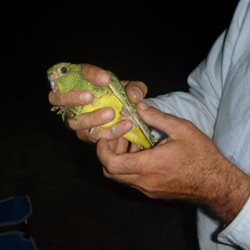
A bird carcass in Queensland in 1990. A single feather inside a wedge-tailed eagle’s nest in South Australia in 2017. A first-in-a-century capture in western Queensland in 2016.
The clues as to the existence of Australia’s most elusive bird have been few and far between.
The night parrot, which was once plentiful among the old growth spinifex of inland Australia, was thought to be extinct for almost 100 years after being last sighted in 1912.
READ MORE: Fears feral deer will become ‘Australia’s next rabbit plague’
In the last two decades, new evidence of its continued existence have sparked a flurry of activity from birdwatchers and hurried measures to protect its dwindling habitat.
Dubbed the ‘Thylacine of the air’, fewer than 20 of the birds are known to inhabit Queensland and up until 2020, there were only occasional detections across Western Australia.
But now, a new find in Western Australia’s remote Pilbara has revealed new hope for the critically endangered species.
A team of researchers from the National Environmental Science Program’s Resilient Landscapes Hub and the University of Queensland have partnered with local Indigenous rangers in the Ngururrpa Indigenous Protected Area (IPA) in the far east of the Pilbara to search for evidence of the elusive bird.
READ MORE: NZ rescuers dismantle wharf to save trapped pygmy blue whale
What they found was the largest known group of night parrots in existence, spanning an area 160km north to south and 90km east to west.
Using audio recorders called songmeters, they conducted nighttime surveys of 31 sites between 2020 and 2023.
At 17 of these locations, they were able to capture the nocturnal bird’s distinctive call.
The research team believe there are likely at least 50 of the birds inhabiting the 17 sites – more than the sum total of all those previously discovered across Australia.
“Before we detected night parrot calls on the Ngururrpa IPA in 2020, there was little awareness that this cryptic, nocturnal bird was still persisting on Ngururrpa Country,” the study authors wrote in the article published today in CSIRO Publishing.
READ MORE: Mysterious pinecone formation appears in US woods
“Once the song of the bird was played, people recalled hearing its whistle as children, and being told that it was an evil spirit.”
At the places where the parrots were detected, camera-traps were then set up to survey predators and collected predator scats for dietary analysis.
Dingoes were commonly spotted in the places were the birds roosted – believed to be a protective force against feral cats, a key threat to the species.
Almost half of the world’s bird species is in decline, with more than 160 species lost globally in the past 500 years.
Invasive species have been a key driver of this, but now the new threat of climate change has overtaken as the leading threat to Australia’s bird life.
The night parrot is no exception, with the greatest threat to its survival believed to be bushfires – which typically occur every six to 10 years in the Ngururrpa Indigenous Protected Area where the new population has been uncovered.
Climate change is leading to more frequent and intense bushfire seasons, threatening the old growth spinifex crucial to the birds’ survival.
The study authors recommended a long-term monitoring program be established on Ngururrpa Country to investigate the birds further and determine whether their population was in decline, stable or increasing.
links to content on ABC
9News





